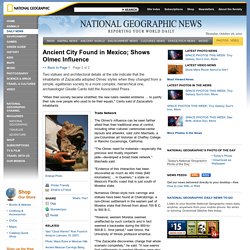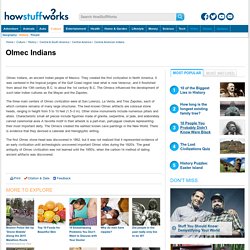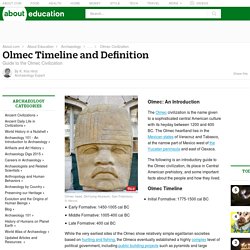

Ancient City Found in Mexico; Shows Olmec Influence. Two statues and architectural details at the site indicate that the inhabitants of Zazacatla adopted Olmec styles when they changed from a simple, egalitarian society to a more complex, hierarchical one, archaeologist Giselle Canto told the Associated Press.

"When their society became stratified, the new rulers needed emblems … to justify their rule over people who used to be their equals," Canto said of Zazacatla's inhabitants. Trade Network The Olmec's influence can be seen farther afield than their traditional area of control, including other cultures' ceremonial-center layouts and artworks, said John Machado, a pre-Columbian art historian at Chaffey College in Rancho Cucamonga, California. "The Olmec need for materials—especially the precious and ritually important jade—developed a broad trade network," Machado said. The New York Times > Science > Mother Culture, or Only a Sister? Published: March 15, 2005 n a coastal flood plain etched by rivers flowing through swamps and alongside fields of maize and beans, the people archaeologists call the Olmecs lived in a society of emergent complexity.

It was more than 3,000 years ago along the Gulf of Mexico around Veracruz. The Olmecs, mobilized by ambitious rulers and fortified by a pantheon of gods, moved a veritable mountain of earth to create a plateau above the plain, and there planted a city, the ruins of which are known today as San Lorenzo. They left behind palace remnants, distinctive pottery and art with anthropomorphic jaguar motifs. Most impressive were Olmec sculptures: colossal stone heads with thick lips and staring eyes that are assumed to be monuments to revered rulers. Olmec Facts, information, pictures.
Cacao use and the San Lorenzo Olmec. In 1996, Sophie Coe and Michael Coe argued in their book The True History of Chocolate that cacao, specifically a chocolate beverage, originated with the Olmec.

They proposed that cacao, originally pronounced “kakawa,” was a vocabulary term used by the ancient Olmec as early as 1000 BCE. Using linguistic evidence, the authors suggested that the Olmec could have been the first to domesticate the cacao tree, Theobroma cacao L., and discovered the chocolate-making process (1). The present study was initiated to test the Coe and Coe hypothesis and to determine whether or not the Olmec at their capital of San Lorenzo consumed cacao products in liquid form. The natural and cultural history of the cacao bean has been the subject of intensive scientific inquiry during the past 25 y. The Olmec Civilization and the Use of Bitumen. Geoarchaeological research has identified origin sources of bitumen used by the great Olmec civilization of the tropical lowlands of central America, 3000 years ago.

The project, described by Olmec scholar David Grove as a “break-though in source analyzing bitumen in Mesoamerica”, may shed light on the vast trade networks throughout prehistoric North America. Historic and Prehistoric Uses of Bitumen Bitumen is a black, oily, viscous material that is a naturally-occurring organic byproduct of decomposed organic materials. Also known as asphalt or tar, bitumen was mixed with other materials throughout prehistory and throughout the world for use as a sealant, adhesive, building mortar, incense, and decorative application on pots, buildings, or human skin. Archaeologists have been investigating the sources of bitumen, that is to say, from whence came bitumen used in ancient settlements, since the 1980s, beginning with materials from archaeological sites in Egypt and Mesopotamia.
The Enigma of the Olmecs - Softpedia. The oldest American civilization Olmec head carving The Olmecs preceded the Maya culture by about a millennium and represent the oldest complex civilization in the Americas.

They were the first to invent a writing system, as revealed by stone (serpentine) blocks, the so-called Cascajal blocks, found in 2006 in Southern Veracruz, Mexico. Their civilization is regarded as "mother" culture for the much more famous Maya and Aztec civilizations. San Lorenzo - Olmec Civilization in Veracruz. San Lorenzo is an Olmec period site located in the state of Veracruz, Mexico.

San Lorenzo is the name of the central place in the larger San Lorenzo Tenochtitlan archaeological region. It is located on a steep plateau above the Coatzacoalcos floodplain. The site was first settled in the second millennium BC and had its heyday between 1200-900 BC. The Decipherment of the Olmec Writing System. Olmec Indians. Olmec Indians, an ancient Indian people of Mexico.

They created the first civilization in North America. It was centered in the tropical jungles of the Gulf Coast region near what is now Veracruz, and it flourished from about the 13th century B.C. to about the 1st century B.C. The Olmecs influenced the development of such later Indian cultures as the Mayan and the Zapotec. People. Olmec, the first elaborate pre-Columbian civilization of Mesoamerica (c. 1200–400 bce) and one that is thought to have set many of the fundamental patterns evinced by later American Indian cultures of Mexico and Central America, notably the Maya and the Aztec.

The Nahuatl (Aztec) name for these people, Olmecatl, or Olmec in the modern corruption, means “rubber people” or “people of the rubber country.” That term was chosen because they extracted latex from rubber trees (Castilla elastica) growing in the region and mixed it with the juice of a local vine (Ipomoea alba) to create rubber. The chief Olmec sites are San Lorenzo, La Venta, Laguna de los Cerros, and Tres Zapotes in what is now southern Mexico. Much of what is known about the Olmec was inferred from archaeological excavations at these sites, which have uncovered large earthen pyramids and platforms and monumental stone carvings. Olmec stylistic influence disappeared after about 400 bce. Olmec Civilization - Timeline and Definition. Olmec: An Introduction The Olmec civilization is the name given to a sophisticated central American culture with its heyday between 1200 and 400 BC.

The Olmec heartland lies in the Mexican states of Veracruz and Tabasco, at the narrow part of Mexico west of the Yucatan peninsula and east of Oaxaca. The following is an introductory guide to the Olmec civilization, its place in Central American prehistory, and some important facts about the people and how they lived. Olmec Timeline Initial Formative: 1775-1500 cal BC Early Formative: 1450-1005 cal BC Middle Formative: 1005-400 cal BC Late Formative: 400 cal BC.
Oldest Writing in New World Discovered, Scientists Say. September 14, 2006 A writing system lost for 3,000 years has been rediscovered on an ancient stone tablet in Mexico, archaeologists say (map of Mexico).

The tablet is the earliest example of writing in the New World, pushing back the origins of writing in the region by several hundred years, according to a paper that will appear in tomorrow's edition of the journal Science. Most likely, the Olmec people, who once lived along the Gulf of Mexico, created the tablet, the researchers say. The Olmecs, famed for their colossal statues of heads, are generally regarded as the first true civilization in the Americas. Until now no one had ever found concrete evidence of Olmec writing. 10 Facts About the Ancient Olmec in Mesoamerica. 9. They were extremely influential The Olmec are considered by historians to be the "mother" culture of Mesoamerica.
The Aztec Capital City of Tenochtitlan - Aztec Culture. The Olmec: Precusors to Mesoamerican History. The Olmec, which translated via the Aztecs, means “rubber people”, were the inspiration behind the other four great main Mesoamerican civilizations namely the Toltec, the Aztecs, the Maya and the Inca, with a decided leaning toward the Maya, who may have been an outgrowth of the Olmec for reasons s we shall explore. We explore them simply because of their profound influence on everything that followed. They were a Pre-Columbian civilization living in the tropical lowlands of south-central Mexico, near the modern-day cities of Veracruz and Tabasco close to the coast before it turns east in the Yucatan peninsula. The Olmec flourished during Mesoamerica's formative period, dating approximately from as early as 1500 BCE to about 400 BCE.
The ancient Olmec Civilization. The ancient Olmec civilization is now considered to be one of the earliest great civilizations in Mesoamerica. This civilization came and went long before the Aztec empire was even thought of, and yet they left their mark on the peoples of Mexico and beyond, and developed a complex culture which is still echoed today, probably in ways we don't yet even realize. (See this possible timeline including the Olmec and Aztec civilizations) The basics The ancient Olmec civilization is believed to have been centred around the southern Gulf Coast of Mexico area (today the states of Veracruz and Tabasco) - further south east than the heart of the Aztec empire.
The Olmec culture developed in the centuries before 1200BC (BCE), and declined around 400BC. The Olmec City of San Lorenzo. The Olmec City of San Lorenzo: The Olmec culture thrived along Mexico’s gulf coast from roughly 1200 B.C. to 400 B.C. One of the most important archaeological sites associated with this culture is known as San Lorenzo. Once there was a great city there: its original name has been lost to time. Considered by some archaeologists to be the first true Mesoamerican city, San Lorenzo was a very important center of Olmec commerce, religion and political power during its heyday.
Location of San Lorenzo: BBC Bitesize - KS2 History - The Aztec Empire. Introduction to the Aztecs exhibition: Melbourne Museum. A pot in the shape of Tláloc, the Aztec rain god. Tláloc is a Nahuatl word that translates as 'He Who Makes Things Sprout'.Image: Michel ZabeSource: Consejo Nacional para la Cultura y las Artes - Instituto Nacional de Antropología e Historia Canny conquerorsTalented artisansHeart-stopping ritualsA nasty ending Aztecs is an exhibition about a highly organised civilisation and the spectacular city it created - Tenochtitlán (pronounced Teh-notch-tit-lan). Was the Aztec Empire Really All Powerful?
The Aztec Civilization. Aztec Math Decoded, Reveals Woes of Ancient Tax Time. Tarlton Law Library - Aztec and Maya Law - online exhibit. The Aztec World. History of Mexico - The Aztec Empire. Aztec Civilization. Aztecs. P B S : C o n q u i s t a d o r s - C o r t é s. People. Aztecs (Mexica) Aztec Calendar : Mexico Culture & Arts. Aztec History. Aztec mythology. Greatest Aztec. Aztec Gods and Goddesses - Ancient / Classical History. Aztecs and the Aztec Civilization. Aztec Religion. Ancient Mayans likely had fountains and toilets - Technology & science - Science - LiveScience. Maya Civilization. Maya Civilization. Mystery of the Maya - Maya civilization. The Mayan Calendar. The Rise and Fall of the Mayan Empire. Collapse: The Maya. History - Ancient History in depth: The Fall of the Mayan Civilisation. How the Mayan Calendar Works" The Mayan Civilization Time Line. Mayan Civilization City of Copan, Honduras.
Mayan Numbers" Climate Change Killed off Maya Civilization, Study Says. Mayan calendar. Intense droughts blamed for Mayan collapse - 13 March 2003. History - Ancient History in depth: The Fall of the Mayan Civilisation. Search the citations of other students: EasyBib: Free Bibliography Maker - MLA, APA, Chicago citation styles. Maya numerals. HISTORY OF THE MAYA. Mayan hieroglyphic writing. Unearthing the Mayan Creation Myth. War of 1812. Constitution 101: The Meaning and History of the U.S. Constitution - Hillsdale College.
Native_american_map.jpg from emersonkent.com - StumbleUpon. Civil War Image Map/Battle Maps. Lincoln-Related Publications at Making of America. Magna Carta: Cornerstone of the U.S. Constitution. Maps of Native American Tribes and Reservations. Native Americans. Native American Code. Encyclopedia of American Studies. History of the Native Americans. Native American Tribes.